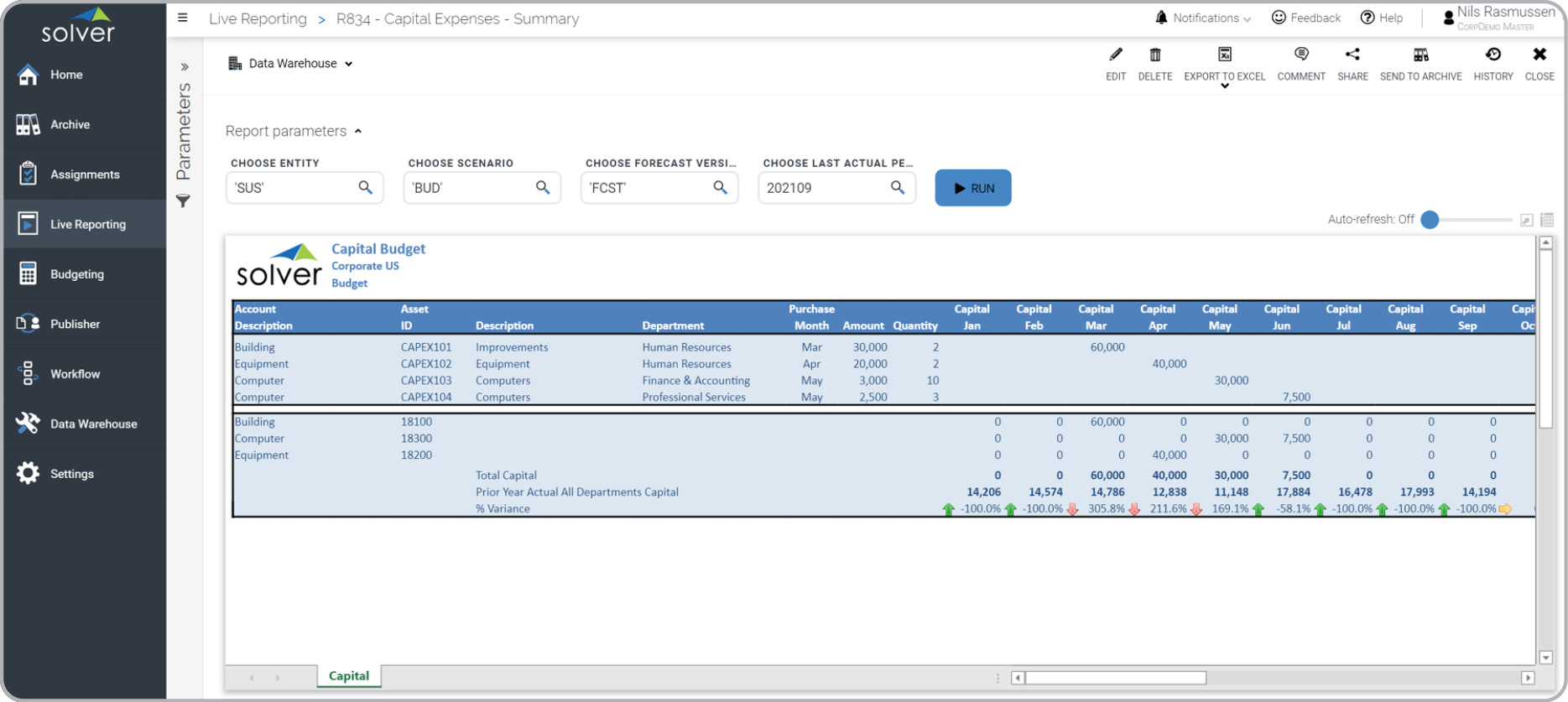Capital Expenditure Budget Report
What is
a
Capital Expenditure Budget Report
? Capital expense ("Capex") reports for budgets are considered analysis tools and are often used by budget managers and CFOs to review how much their department heads plans to spend on asset purchases next year. Some of the key functionality in this type of budget analysis report is that it can be run for any company and budget version. It shows planned purchases by asset type and department. Furthermore it shows expected purchase month, quantity, and total amount. At the bottom of the report it summarizes the transactions up to the respective general ledger (GL) accounts and compares the budget to actual and forecast for the current year. You find an example of this type of budget analysis report below.
Purpose of
Capex Budget Reports Companies and organizations use Capital Expenditure Budget Reports to easily review and decide on proposed or approved asset purchase budgets. When used as part of good business practices in a Financial Planning & Analysis (FP&A) department, a company can improve its capital investment plans and cost control as well as reduce the chances that it over- or under spends on new assets.
Capital Expenditure Budget Report
Example Here is an example of a Capital Expenditures Budget Analysis Report that shows proposed asset purchases and costs for all departments. [caption id="" align="alignnone" width="1869"]
 Capital Expenditure Budget Report Example[/caption] You can find hundreds of additional examples
here
Who Uses This Type of
Budget analysis report
? The typical users of this type of budget analysis report are: CFOs, budget managers, and department heads.
Other
Budget analysis report
s Often Used in Conjunction with
Capital Expenditure Budget Reports Progressive Financial Planning & Analysis (FP&A) Departments sometimes use several different Capital Expenditure Budget Reports, along with capex budget input forms, asset reports, depreciation reports, budget dashboards and other management and control tools.
Where Does the Data for Analysis Originate From? The Actual (historical transactions) data typically comes from enterprise resource planning (ERP) systems like: Microsoft Dynamics 365 (D365) Finance, Microsoft Dynamics 365 Business Central (D365 BC), Microsoft Dynamics AX, Microsoft Dynamics NAV, Microsoft Dynamics GP, Microsoft Dynamics SL, Sage Intacct, Sage 100, Sage 300, Sage 500, Sage X3, SAP Business One, SAP ByDesign, Acumatica, Netsuite and others. In analyses where budgets or forecasts are used, the planning data most often originates from in-house Excel spreadsheet models or from professional corporate performance management (CPM/EPM) solutions.
What Tools are Typically used for Reporting, Planning and Dashboards? Examples of business software used with the data and ERPs mentioned above are:
Capital Expenditure Budget Report Example[/caption] You can find hundreds of additional examples
here
Who Uses This Type of
Budget analysis report
? The typical users of this type of budget analysis report are: CFOs, budget managers, and department heads.
Other
Budget analysis report
s Often Used in Conjunction with
Capital Expenditure Budget Reports Progressive Financial Planning & Analysis (FP&A) Departments sometimes use several different Capital Expenditure Budget Reports, along with capex budget input forms, asset reports, depreciation reports, budget dashboards and other management and control tools.
Where Does the Data for Analysis Originate From? The Actual (historical transactions) data typically comes from enterprise resource planning (ERP) systems like: Microsoft Dynamics 365 (D365) Finance, Microsoft Dynamics 365 Business Central (D365 BC), Microsoft Dynamics AX, Microsoft Dynamics NAV, Microsoft Dynamics GP, Microsoft Dynamics SL, Sage Intacct, Sage 100, Sage 300, Sage 500, Sage X3, SAP Business One, SAP ByDesign, Acumatica, Netsuite and others. In analyses where budgets or forecasts are used, the planning data most often originates from in-house Excel spreadsheet models or from professional corporate performance management (CPM/EPM) solutions.
What Tools are Typically used for Reporting, Planning and Dashboards? Examples of business software used with the data and ERPs mentioned above are:
- Native ERP report writers and query tools
- Spreadsheets (for example Microsoft Excel)
- Corporate Performance Management (CPM) tools (for example Solver)
- Dashboards (for example Microsoft Power BI and Tableau)
Corporate Performance Management (CPM) Cloud Solutions and More Examples
November 28, 2020
TAGS:
Reporting,
Solver,
report writer,
Microsoft,
template,
practice,
Acumatica,
Netsuite,
Finance,
GP,
asset,
Business Central,
excel,
ax,
forecast,
Budget,
forecasting,
budgeting,
Cloud,
Software,
Tableau,
SAP,
example,
best,
Sage,
BC,
D365,
NAV,
Intacct,
CPM,
report,
SL,
Management,
dynamics,
Power BI,
capex,
purchase,
capital,
capital expense report,
capital expenditure

